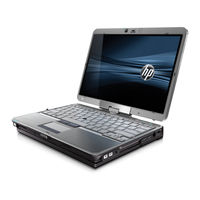
HP ELITEBOOK 2740P Manuals
Manuals and User Guides for HP ELITEBOOK 2740P. We have 6 HP ELITEBOOK 2740P manuals available for free PDF download: User Manual, Maintenance And Service Manual, Driver Installation, Overview
HP ELITEBOOK 2740P User Manual (179 pages)
Table of Contents
-
1 Features
13 -
3 Networking
32-
Using a WLAN35
-
-
5 Multimedia
73 -
-
7 Drives
98 -
-
-
11 Security
124-
Using Passwords125
-
15 Multiboot
157 -
-
Index
173
Advertisement
HP ELITEBOOK 2740P User Manual (175 pages)
Table of Contents
-
1 Features
13 -
3 Networking
32-
Using a WLAN36
-
-
5 Multimedia
72 -
-
7 Drives
95 -
-
11 Security
119-
Using Passwords120
-
15 Multiboot
154 -
-
Index
169
HP ELITEBOOK 2740P User Manual (168 pages)
Table of Contents
-
Lights15
-
Keys17
-
Display23
-
Using a WLAN36
-
Audio68
-
Video70
-
Webcam71
-
Memory Modules109
-
Using Passwords114
-
Using F11139
-
File Menu143
-
Diagnostics Menu144
-
Index161
Advertisement
HP ELITEBOOK 2740P Maintenance And Service Manual (117 pages)
Tablet PC
Table of Contents
-
-
-
Service Tag44
-
Pen46
-
Battery47
-
Sim48
-
Hard Drive49
-
WLAN Module51
-
WWAN Module54
-
Keyboard56
-
Top Cover59
-
RTC Battery61
-
Modem Module75
-
System Board78
-
Misc Cables83
-
-
-
Windows 797
-
Windows Vista101
-
Windows XP104
-
-
-
External Monitor108
-
Modem)109
-
Network)109
-
Index
113
HP ELITEBOOK 2740P Driver Installation (20 pages)
Installing SATA Drivers on HP EliteBook Notebook PCs
Table of Contents
HP ELITEBOOK 2740P Overview (16 pages)
2008 HP business notebook PC F10 Setup overview
Table of Contents
Advertisement





